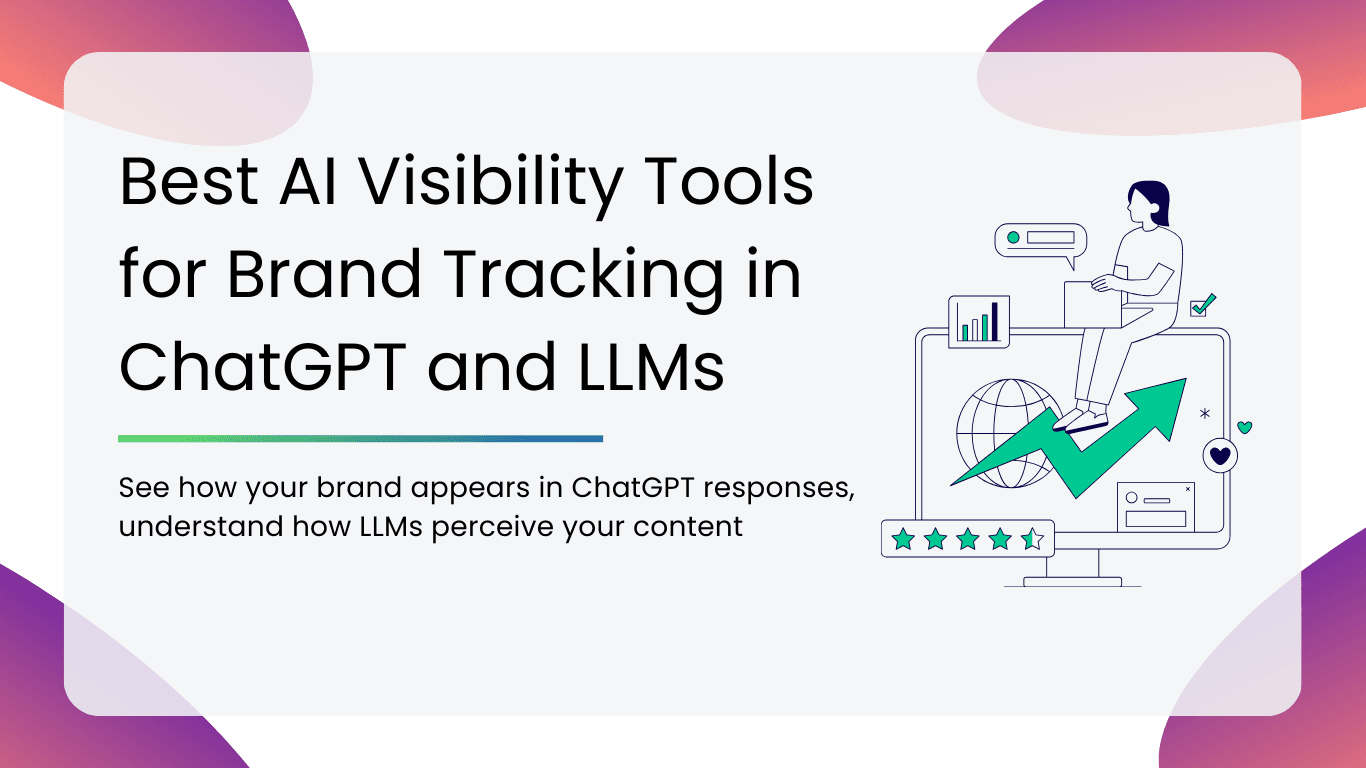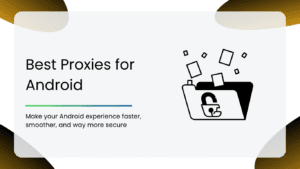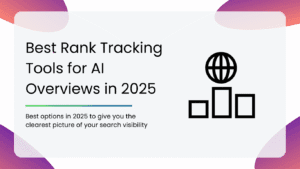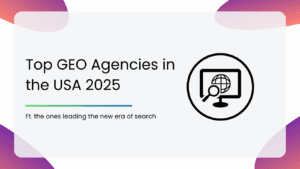Keeping tabs on how your brand shows up inside AI systems isn’t like tracking Google search rankings or social media mentions. It’s a new landscape with new rules. That’s where AI visibility tools come in.
These platforms help you see how your brand appears in ChatGPT responses, understand how LLMs perceive your content, and uncover opportunities to shape your AI presence before your competitors do.
In this guide, we’ll dive into the best AI visibility tools out there right now and show you how they can help you monitor, measure, and master brand presence on ChatGPT and other LLMs.
What are AI Visibility Tools?
AI visibility tools monitor how your brand appears inside AI-driven platforms like ChatGPT and other Large Language Models (LLMs). These tools help you:
1. Discover Mentions in AI Responses
See where and how your brand is being referenced in ChatGPT, Gemini, Claude, and other LLMs.
2. Measure Sentiment & Context
Understand whether the mentions are positive, neutral, or negative, and in what context they’re appearing.
3. Spot Data Gaps
Identify missing or outdated information about your brand in AI systems and know where you need to supply better content.
4. Benchmark Competitors
Compare your brand’s presence in AI-generated answers to your competitors’ and spot opportunities.
Why AI Visibility Matters in 2025
Here’s why AI visibility matters right now:
1. AI is the New Search
People are bypassing traditional search engines and heading straight to conversational AI. If you’re not being mentioned here, you’re missing prime digital real estate.
2. First-Mover Advantage
The brands that establish visibility early inside LLMs will dominate long before others catch up, just like early SEO adopters ruled Google.
3. Trust Through AI Mentions
When AI tools recommend or cite your brand, it creates implicit credibility. This can drive trust faster than ads or social proof.
4. Competitive Intelligence
Tracking your competitors inside AI systems gives you a peek into their strategy and where you can outperform them.
How to Choose the Right AI Visibility Tool
Here are the key features to look for, and why they matter:
| Feature | What to Check | Why It’s Important |
| Supported Platforms | Does the tool track ChatGPT, Perplexity, Microsoft Copilot, AI Overviews, etc.? | If it doesn’t monitor the LLMs and AI interfaces your audience actually uses, you’ll be flying blind. |
| Integration with Your Existing SEO/Marketing Stack | Can it pull data from Google Analytics (GA), Google Search Console (GSC), or your CRM? | Helps you stitch together what you already know and what AI visibility adds. Enables richer insights/avoids duplicated work. |
| Metrics & Reporting | Mentions count, sentiment (positive/negative/neutral), share of voice, competitor comparison. | Raw mentions are good; knowing how your brand is talked about and against who is what turns info into strategy. |
| Recommendations Engine | Does the tool suggest actions, like what content to update, what gaps to fill, how to optimize prompts? | Data is only useful if you can act on it. Tools that give prescriptive insights save you time and help you move faster. |
| Pricing & Scalability | Is there a free plan? Pay-as-you-go? Enterprise-level pricing? How many brands, keywords or users are included? | You want something that fits your budget and can grow. A low-cost tool that breaks when you scale isn’t helpful. |
| User-Friendliness | Clean dashboard, alert systems, ability to export data, mobile-accessible UI, easy onboarding. | If the tool is too complex, your team won’t use it; slow dashboards and clunky UX can lead to frustration and missed opportunities. |
Comparison Table of Best AI Visibility Tools for Brand Tracking in ChatGPT and LLMs
| Tool | Metrics & Reporting | Recommendations Engine | User Friendliness |
| SE Ranking | Brand visibility, competitor comparison, trend tracking, AI citations | Prompts & content suggestions for AI visibility | Simple UI, Easy-to-use dashboard |
| Peec AI | Brand visibility, AI citations, top sources | Suggested actions based on AI mentions | Simple UI, exportable reports |
| Profound | Mentions sentiment, competitor ranking | Content & campaign optimization | Easy-to-use dashboards |
| Rankscale | Brand visibility, GEO ranking, citations | Prompts & content suggestions for AI visibility | Moderate learning curve |
| Otterly | Prompt tracking, AI response analysis | Recommendations for optimizing prompts | Modern dashboard, real-time updates |
| Semrush AI | Keyword impact, AI visibility, SEO recommendations | SEO & content recommendations | Familiar SEO interface |
| Evertune.ai | AI Brand Index, sentiment, competitor comparison | GEO-based content recommendations | User-friendly for marketers |
| Rankability | Citation & sentiment tracking, alerts | Actionable insights for improving AI ranking | Slight learning curve |
| Wix AI | Mentions in AI responses, visibility score | Limited; insights are mostly descriptive | Very simple, minimal features |
Best AI Visibility Tools for Brand Tracking in ChatGPT and LLMs
| Table of Contents |
| 1. SE Ranking |
| 2. Peec AI |
| 3. Profound |
| 4. Rankscale |
| 5. Otterly |
| 6. Semrush AI |
| 7. Evertune.ai |
| 8. Rankability |
| 9. Wix AI |
1. SE Ranking
SE Ranking offers one of the most comprehensive AI visibility tracking solutions available, covering Google AI Overviews, AI Mode, Gemini, Perplexity, and ChatGPT in a single platform. It gives you cross-platform insights, historical tracking, competitive benchmarking, and regular updates wrapped in an intuitive interface.
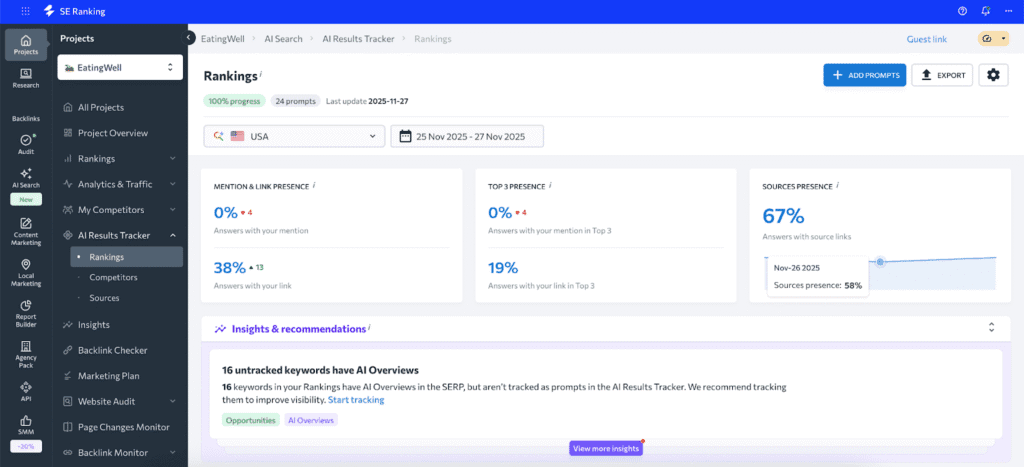
Key Features:
- Brand and Link Tracking: See which prompts trigger AI answers featuring your brand, where your links and mentions appear in those answers, and whether you’re landing in the top 3 positions.
- Competitor Benchmarking: Monitor who else appears alongside your brand, compare visibility metrics side-by-side, and identify gaps where competitors are getting cited but you’re not.
- Historical Trends: Get historical tracking to measure optimization impact, spot visibility shifts, and catch volatility before it becomes a problem.
- Cached AI Answers: View stored copies of AI responses to understand exactly how your brand and competitors are being presented in context.
- Top-Cited Sources: Identify which pages AI systems cite most frequently, helping you build outreach strategies to increase your chances of future mentions.
Cons:
- No sentiment analysis yet: The platform doesn’t analyze sentiment automatically, but users can check the stored AI answer to see the context or use a separate add-on.
- Learning Curve: Users new to AI search tracking may need time to understand the workflows, though SE Ranking provides educational materials and support to help.
Review: SE Ranking is a strong choice if you want a complete view of your AI visibility without switching between platforms or tools. The combination of cross-platform coverage, competitor intelligence, and historical data makes it especially valuable for SEO teams and brands that need to track trends, measure campaign impact, and stay ahead of visibility shifts.
2. Peec AI
Instead of guessing where people are seeing or mentioning your brand in AI-generated responses, Peec AI gives you a dashboard to see those mentions, track metrics over time, compare with competitors, and spot prompt-based visibility gaps. It’s not perfect, but for many brands, it’s one of the more polished options in this growing space.
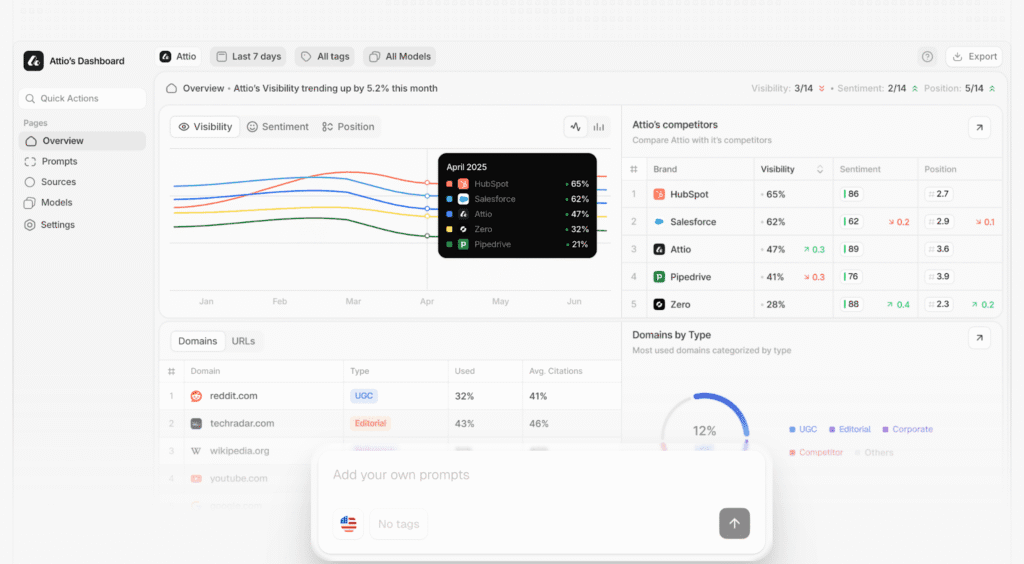
Key Features:
- Prompt Tracking: You can define prompts and see how your brand appears for those prompts.
- Brand Mentions: Metrics include how often your brand is mentioned, how visible it is across sources, the number of citations from different sources, etc.
- Source & URL Analysis: Peec AI also shows where your brand is being cited, which URLs, and domains are influencing your visibility.
- Competitor Tracking: Add competitors and see how you measure up in visibility, prompt usage, citations, etc.
- Timeline & Trend Graphs: View data over time to see trends in mentions or visibility, and see how things change day by day.
Cons:
- Limited Actionable Insights: The tool is weaker on how to improve it. The actionable steps or optimization suggestions are minimal.
- No Rich Historical Data: You can’t retroactively get data from before you started tracking.
Review: Peec AI is a solid pick if you’re a brand that already has some presence. It gives you clarity: what prompts are working, where you are getting cited, and how you match up to competitors. That visibility alone is worth a lot, because until now, many brands have been blind in this space.
3. Profound

Profound is built for brands that want to see exactly how, where, and how often they show up inside ChatGPT, Perplexity, Copilot, Google AI Overviews, and more. It’s enterprise-grade, polished, focused on visibility, citations, prompt trends, and supporting brands in optimizing how they appear in AI-driven responses.
Key Features:
- Answer Engine Insights: You get visibility scores, share of voice versus competitors, and tracking of citations.
- Conversation Explorer: You can see what people are asking AI systems, trending prompts, and topic clusters.
- Shopping Insights: E-commerce brands can see which product pages are appearing, under what keywords, how retailers are faring, etc.
- Agent Analytics: Understand how AI crawlers are accessing your content, how your site is being interpreted by those crawlers, and what technical optimization might be needed.
- Actionable Recommendations: Profound gives actions or content brief suggestions, helps you find gaps, suggests optimizations,and helps you build content workflows.
Cons:
- Price: The entry tier is expensive and still limited in seats, history, API access, etc.
- Feature Limits: The lower plans often have caps on how many responses/prompts you can track, how much historical data you can access, and limited integrations.
Review: Profound is apt for seeing how your brand shows up in AI-driven answer engines. If you have enough budget and internal bandwidth, it offers real visibility, competitive intelligence, and strategic insights that are otherwise opaque.
4. Rankscale
Rankscale promises to go deeper than just mentions. You can understand how visible you are, what answer-sources are quoting you, which queries show you, and how you measure against competitors. If you want a tool that blends visibility tracking with analytical depth, especially in AI-dominated conversational or answer-engine environments, Rankscale is one to try.
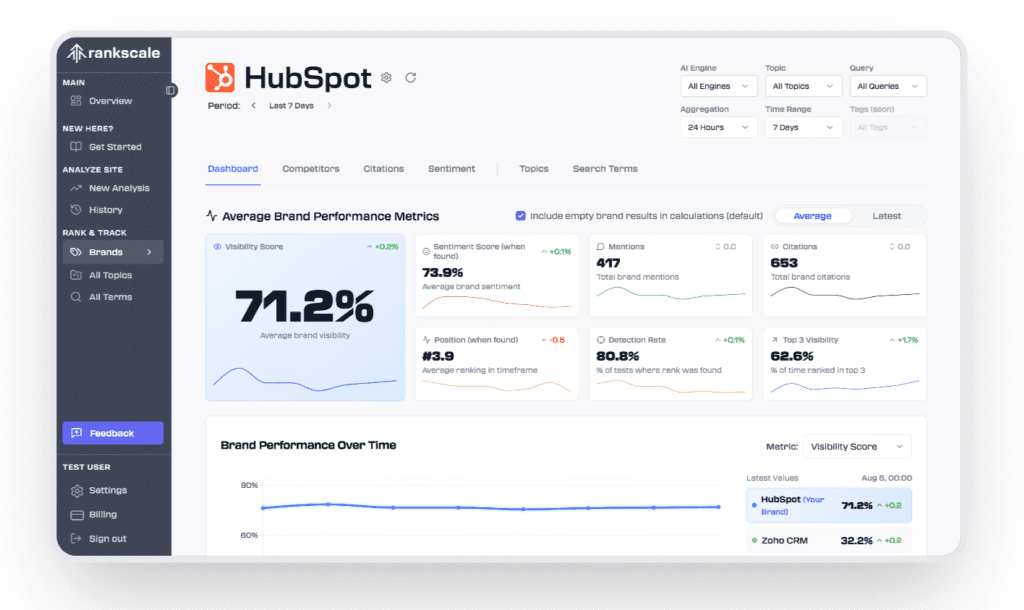
Key Features:
- AI Search Engine: Rankscale monitors how often your brand is referenced or quoted by AI search engines or LLM-powered systems.
- Prompt Monitoring: You can see which natural-language prompts or queries are triggering your brand’s visibility.
- Competitor Comparison: You can benchmark your visibility and presence against competitors.
- Trend Graphs: Rankscale offers trend visualizations: how your visibility moves, spikes or drops, and comparison with competitors over time.
- Alerts & Notifications: Get alerted when there are significant changes, helping you respond quicker than always looking manually.
Cons:
- Learning Curve: If you’re new to AI visibility, there may be a steeper ramp.
- Early Stage/Data Gaps: Some platforms or answer types may not yet be monitored; some data may be modeled or inferred rather than directly observed.
Review: Rankscale shines if you want more than superficial brand mention counts. For brands serious about being inside AI’s answer engine layer, this level of insight matters. You can detect when visibility shifts happen, whether good or bad, and respond promptly.
5. Otterly
If you care about generative engines and want to shape your brand’s standing ahead of the curve, Otterly is one of the tools worth checking. It is a strong choice if your goal is to monitor and understand AI visibility, catch trends, respond to what AI systems are doing, benchmark against competition, and build from there.
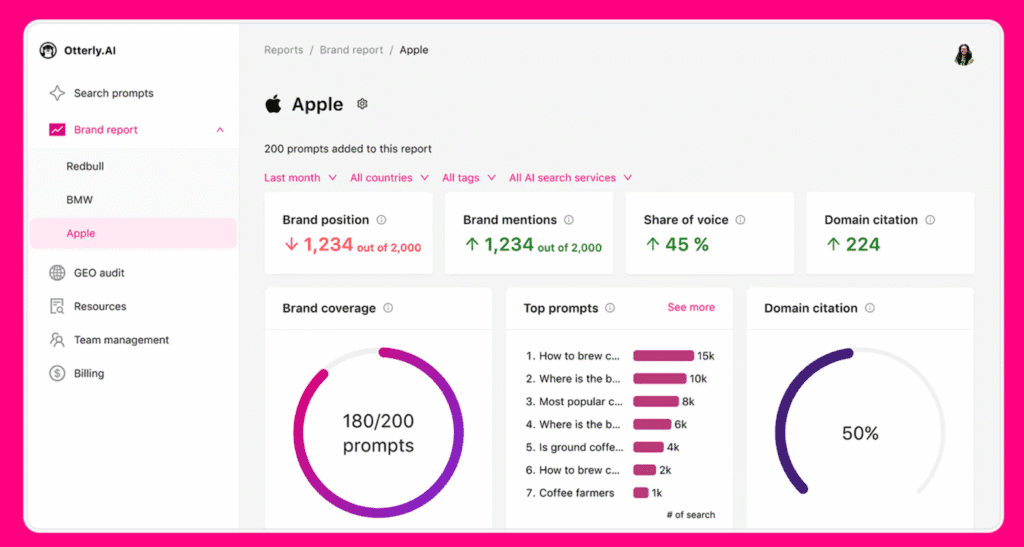
Key Features:
- Prompt Research: Not just a traditional keyword to prompt transformation. Otterly helps you generate conversational prompts people are likely using.
- Brand & Link Citation Tracking: See which URLs are being cited by AI search results, which pages are giving you citations, and how these change over time.
- Sentiment Monitoring: Otterly shows how your brand was mentioned in AI-search outputs.
- GEO Audits: You can configure prompts and visibility tracking per country/region, which matters because answers/citations/brand presence in these AI tools often vary by geography.
- Regular Reporting: Weekly reports, dashboards showing trends, ability to export link-lists, citations, and visibility data so you can build external reports.
Cons:
- Setup Complexity: Because Otterly gives many features, setting up your brand, choosing prompts, and mapping competitors can be a bit complex.
- UI Overwhelm: With many options, the interface can feel a bit cluttered.
Review: Otterly is one of the most capable tools in this AI visibility/Generative Engine Optimization (GEO) space right now, especially for marketers who want to monitor and understand before diving deep into optimization.
6. Semrush AI
By integrating traditional SEO insights with AI-specific analytics, Semrush AI offers a unified approach to understanding and improving your brand’s presence in AI-generated responses. Whether you’re aiming to increase your share of voice or refine your content strategy, Semrush AI provides the tools to navigate the evolving landscape of AI search visibility.
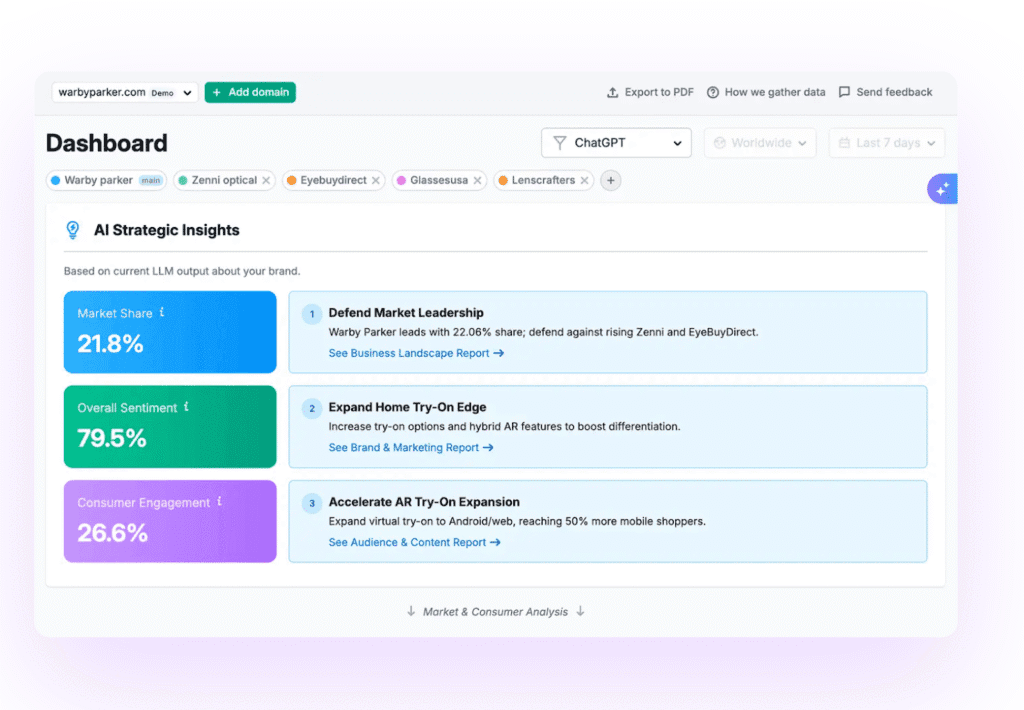
Key Features:
- Sentiment Analysis: The platform assesses the tone of AI-generated mentions, helping you understand whether your brand is portrayed positively, negatively, or neutrally.
- Competitive Benchmarking: Compare your brand’s AI visibility against industry competitors to identify strengths, weaknesses, and opportunities for improvement.
- Prompt-Level Insights: Gain access to specific prompts where your brand is mentioned or missing, allowing for targeted content optimization.
- Content Citation Analysis: Discover which of your content pages are most frequently cited in AI responses, informing your content strategy and SEO efforts.
- Strategic Recommendations: Receive actionable insights on how to improve your AI visibility, including content optimization tips and best practices for AI search platforms.
Cons:
- Enterprise-Level Pricing: The pricing may be a consideration for smaller businesses or startups.
- Complexity for New Users: The range of tools and analytics can be overwhelming for those new to AI visibility tracking.
Review: Semrush AI provides a holistic view of brand visibility across multiple platforms. While the pricing may be steep for some, the depth of insights and strategic recommendations offered make it a valuable investment for businesses aiming to stay ahead in the AI-driven search landscape.
7. Evertune.ai
By focusing on Generative Engine Optimization (GEO), Evertune.ai provides insights into how large language models (LLMs) perceive and recommend brands. This approach enables marketers to shape their brand presence proactively in AI-generated responses, moving beyond traditional SEO metrics to influence AI-driven discovery effectively.
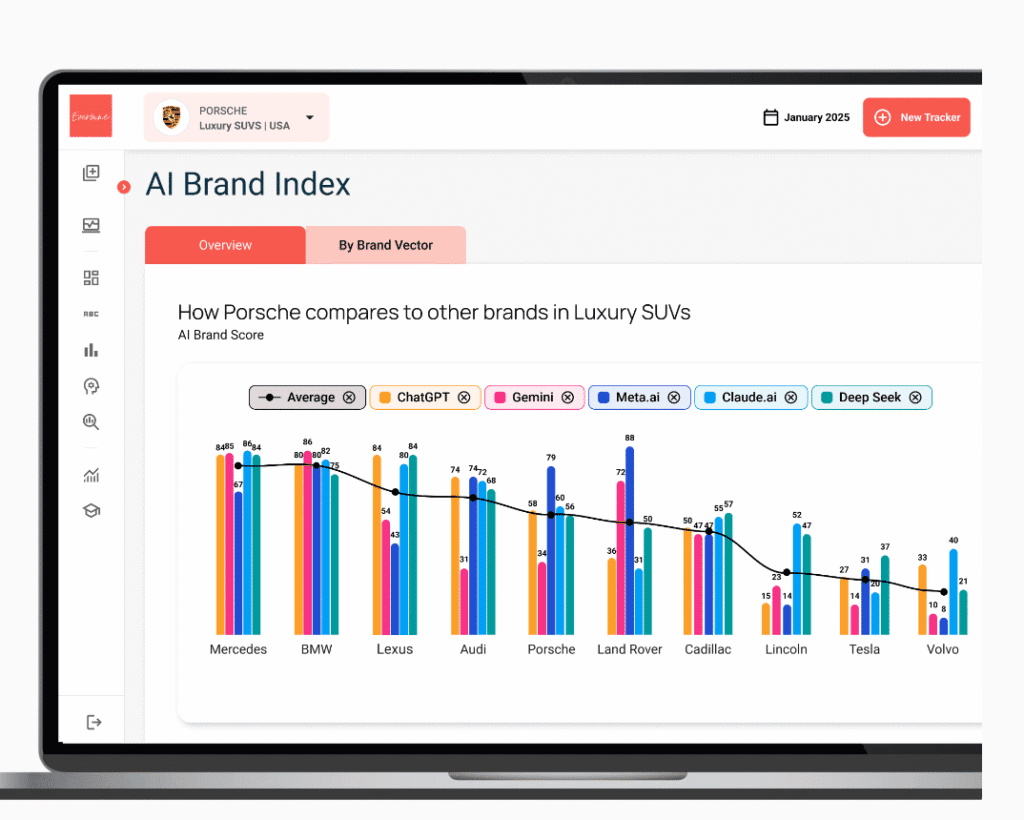
Key Features:
- AI Brand Index: It quantifies how often and how favorably a brand is recommended by AI models across various product categories.
- Sentiment Analysis: The platform helps brands understand the tone and context in which they are presented.
- Competitive Benchmarking: Evertune.ai allows brands to compare their AI visibility against competitors, highlighting strengths and identifying gaps in brand representation within AI responses.
- Content Strategy Recommendations: Evertune.ai provides actionable content strategy recommendations, helping brands optimize their messaging and content to align with AI-generated responses, improving brand visibility and relevance.
- Influencer & Community Insights: The platform identifies key websites, influencers, and communities that influence AI model training citations.
Cons:
- Limited Technical SEO Tools: Brands may need to integrate additional tools to address all aspects of their digital presence.
- Basic Sentiment Analysis: The tracking capabilities can be basic compared to a more specialized sentiment analysis tool.
Review: Evertune.ai offers a robust solution for brands aiming to enhance their visibility in AI-driven search environments. While this is definitely a pro, brands seeking comprehensive SEO solutions or advanced enterprise features may need to consider additional tools to meet all their digital marketing needs.
8. Rankability
Rankabiity is a powerful AI search intelligence platform focusing on citation data, sentiment analysis, and competitive benchmarking. It allows marketers to pinpoint opportunities to improve visibility and optimize content for generative AI environments.
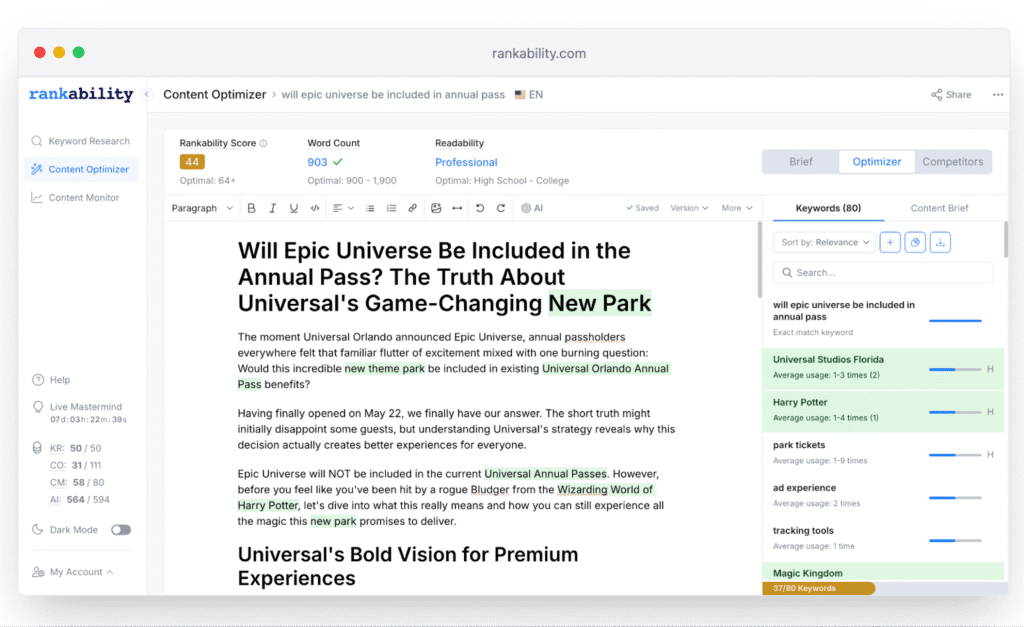
Key Features:
- AI Search Visibility Tracking: Track how often your brand is mentioned and where it ranks in AI-generated responses.
- Competitive Benchmarking: Compare your brand’s AI visibility against competitors to identify strengths, weaknesses, and opportunities for improvement.
- Prompt-Level Insights: Gain insights into specific prompts that trigger brand mentions.
- Citation Analysis: Identify which of your content pages are being cited in AI responses.
- Real-Time Alerts: Receive notifications about significant changes in your brand’s AI visibility.
Cons:
- Pricing Structure: The pricing may be a consideration for smaller businesses or startups.
- Dependence on AI Platform Algorithms: Changes in AI algorithms can impact the accuracy and relevance of visibility tracking.
Review: Rankability is a specialist tool built for brands that want real-time AI search intelligence. Its strength lies in proactive insights, helping you make strategic content decisions before your competitors do. The only drawback is that its depth can feel overwhelming for casual users.
9. Wix AI
Wix AI is a built-in feature for Wix websites that tracks how often your site is cited by AI platforms. It provides quick insights into brand mentions, visibility scores, and competitor comparisons, making it an easy-to-use tool for Wix users who want to monitor their AI presence without leaving their website space.
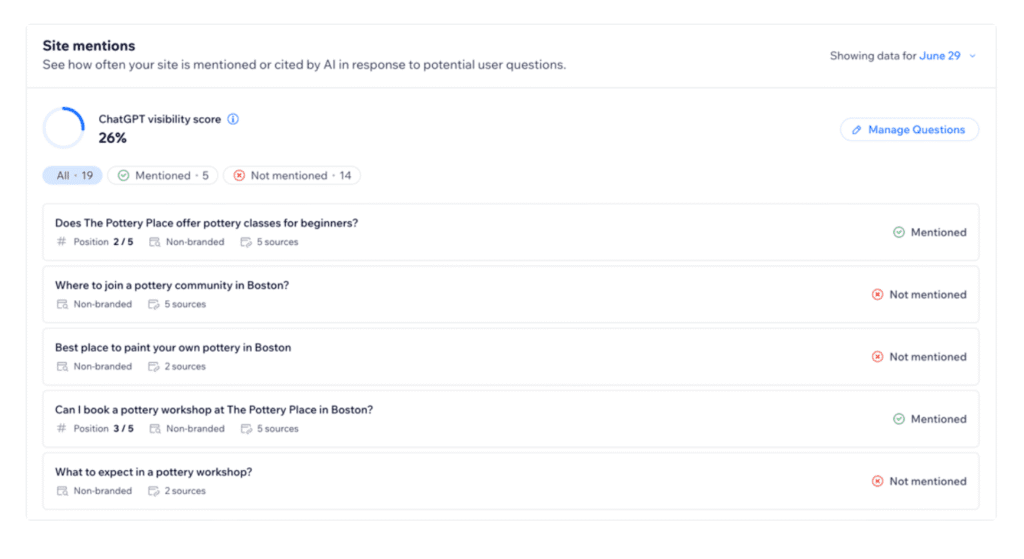
Key Features:
- AI Platform Selection: Choose from ChatGPT, Gemini, or Perplexity to analyze your site’s performance on each platform.
- Site Mentions: View the percentage of questions in which your site was mentioned or cited.
- Top Sources by References: Identify which external sites are frequently cited by AI platforms, helping you understand your competitors’ sources.
- Brand Perception: Assess how AI perceives your brand by reviewing AI-generated responses about your business’s strengths and weaknesses.
- Traffic from AI Platforms: Monitor user sessions and bot visits originating from AI platforms.
Cons:
- Availability: The AI Visibility Overview is not yet available to all users.
- Data Limitations: Traffic data is currently available only for ChatGPT and Perplexity bots.
Review: Wix AI Visibility is tailored for users already in the Wix ecosystem, offering a hassle-free way to monitor AI mentions and visibility scores. Its strength lies in simplicity and immediate insights, making it an excellent starter tool for beginners.
The right tool depends on your brand’s priorities: whether you want deep analytical insights, actionable recommendations, or simple visibility tracking within your current CMS. All these platforms are designed to make AI brand tracking easier, faster, and more precise, helping you turn data into strategy and AI visibility into real-world growth.
Pick the tool that aligns with your goals, dive in, and start shaping your brand’s presence in the AI era.
Want to explore more AI-driven marketing insights? Check out our other Smacient blogs:
- Best AI Calendar Assistant/Scheduling Tools in 2025
- AI Agents for Marketing: A Complete Guide
- How to Turn Marketing Data Into Insights Using AI
FAQs
Most AI visibility tools are designed to be user-friendly, with intuitive dashboards and built-in tutorials. For basic tracking and reporting, you can get started in a few hours. However, to fully leverage advanced features, expect a learning curve of 1 to 2 weeks.
Hidden costs may include usage-based fees, limits on the number of tracked prompts, or additional charges for exporting reports. Always review pricing pages carefully and consider your business’s specific needs to avoid unexpected expenses.
Some tools actively update their coverage to include new LLMs as they gain traction. If tracking emerging models is critical, check whether the platform offers continuous updates or custom integration options for newer AI engines.
Brands should audit their AI visibility at least once a month to track changes, monitor competitor performance, and catch emerging trends. For high-volume businesses, a weekly audit can provide more actionable insights.
Disclosure – This post contains some sponsored links and some affiliate links, and we may earn a commission when you click on the links at no additional cost to you.
